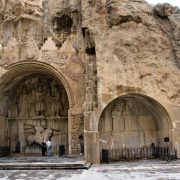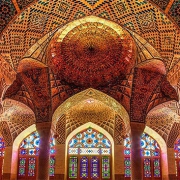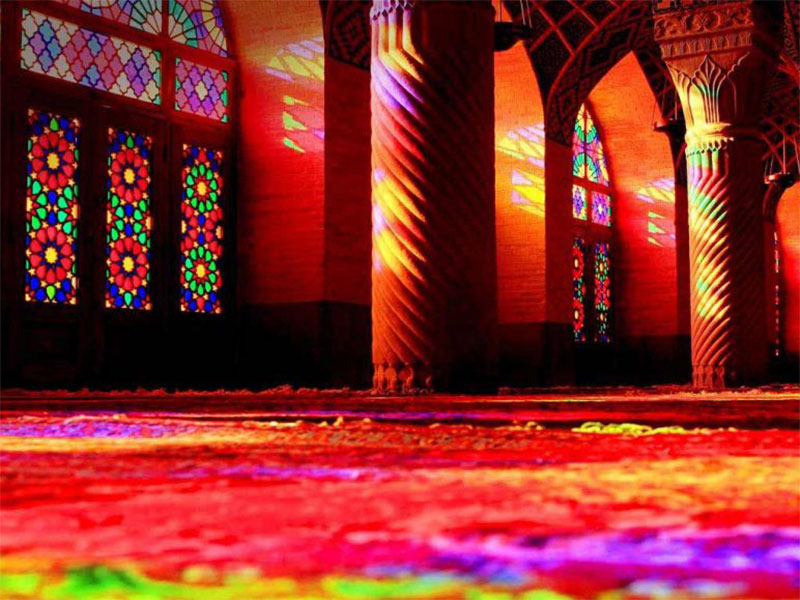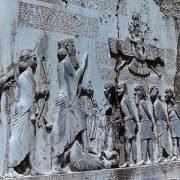The long history and the vast area of Iran have led to amazingly variant climatic conditions, cultural attractions, and natural landscapes. That is why Iran is famous as a destination for all four seasons, a land that offers loads of opportunities for all nature and adventure lovers who dream of various thrilling experiences such as climbing, canyoning, skiing, marine activities, and safari.
What is famous in Iran? Well, the best of Iran includes 24 UNESCO Cultural Heritage Sites and two UNESCO Natural Site as well as 13 Intangible Cultural Heritage registered on UNESCO and many more registered on Iran National Heritage List, that has made this country resemble like a live museum for all avid culture lovers, too. And surprisingly there are still more places you can visit!
Iran’s top attractions appeal to many international tourists from all around the world. Most itineraries offer 7 days to a 14-day tour to Iran, and yet they miss many tourist attractions in Iran! As long as you stay here, there is no shortage of Iran tourist attractions and there are places worth visiting.
If you have decided to visit historical places in Iran or Iran’s fascinating sceneries you can trust Iran Doostan Tours Co. We have a good three decades of experience in operating incoming tours to Iran and our professional experts would offer you the best Iran tourist map with reliable itineraries and high-quality services. Regarding a great deal of Iran attractions, we offer a diversity of package tours to Iran ranging from exciting adventure tours such as climbing and bird watching to awesome cultural tours to world heritage sites. MICE tours, safari tours, religious tours, and medical tours to Iran is also among the variety of services we offer.
All you have to do is to get in touch with us through info@idt.ir.
Posts
Fin Garden in Kashan: Photos, Architecture, Plan, History
Fin Garden, also known as Bagh-e-Fin, in Kashan, is one of nine fascinating Persian gardens on the UNESCO world heritage list. Fin Garden is a historical garden and one of the most visited tourist attractions in Isfahan province. It attracts many tourists and travelers from around the world. This garden dates back to the 16th century when the Safavid dynasty ruled. Then it underwent some reconstruction in the late 19th century. It was highly recognized and expanded during the reign of Fat′h Ali Shah Qajar in the 19th century. The garden may date back to before the Safavid period; however, no valid document is available. During the reign of King Abbas I of Persia, the Persian garden was reconstructed into its current form. Travel to Iran and visit Fin Garden in Kashan to experience how it feels to step into heaven.
Fin Garden History
The plan of the Fin Garden is a kind of elaborated Chahar Bagh with a pavilion at the intersection. As a traditional Chahar Bagh with a large area of thousands of square meters, it is surrounded by trees, shrubs, water flows, and a high curtain wall with circular towers separating this oasis from the surrounding desert. Fin Garden is also famous for its historical tragedy. Amir Kabir was the chief minister to Naser al-Din Shah Qajar. He was one of the most innovative men in the Qajar period and was murdered in Fin Garden in 1852. Once registered as national property, Fin Garden became a UNESCO World Heritage Site. Some believe that Ghiyāth al-Dīn Jamshīd Kāshānī, a Persian astronomer and mathematician, was the designer of the garden. On the other hand, some say it was the great art of Sheikh Bahaei, a Shia Islamic scholar, architect, mathematician, and poet who lived in the late 16th and early 17th centuries.
A Heaven in Hiding
Fin Garden, a splendid sample of Persian gardens, exhibits a good combination of nature, culture, history, and architecture. All architectural elements are elaborately applied to make a masterpiece that absorbs eyes for a long time. Persian gardens mainly lie in the heart of deserts. Seeing such magnificent green places in hot and arid areas would keep travelers in awe.
The construction of the pavilion in the middle of the garden, along with two dynamic elements of trees and water, brings about the identity of this cultural and historical attraction. Water plays a vital role in the design of Fin Garden. The sound of the flowing water can truly ease one’s soul. To have a perfect day in Fin Garden, do not forget to visit Fin Garden tea-house near the source of the spring. There are many trees shading the water full of fish. Travel to Iran and enjoy exploring one of the most beautiful examples of Persian architecture. Stroll around and listen to the peaceful sound of running water and the whistling sound of leaves.
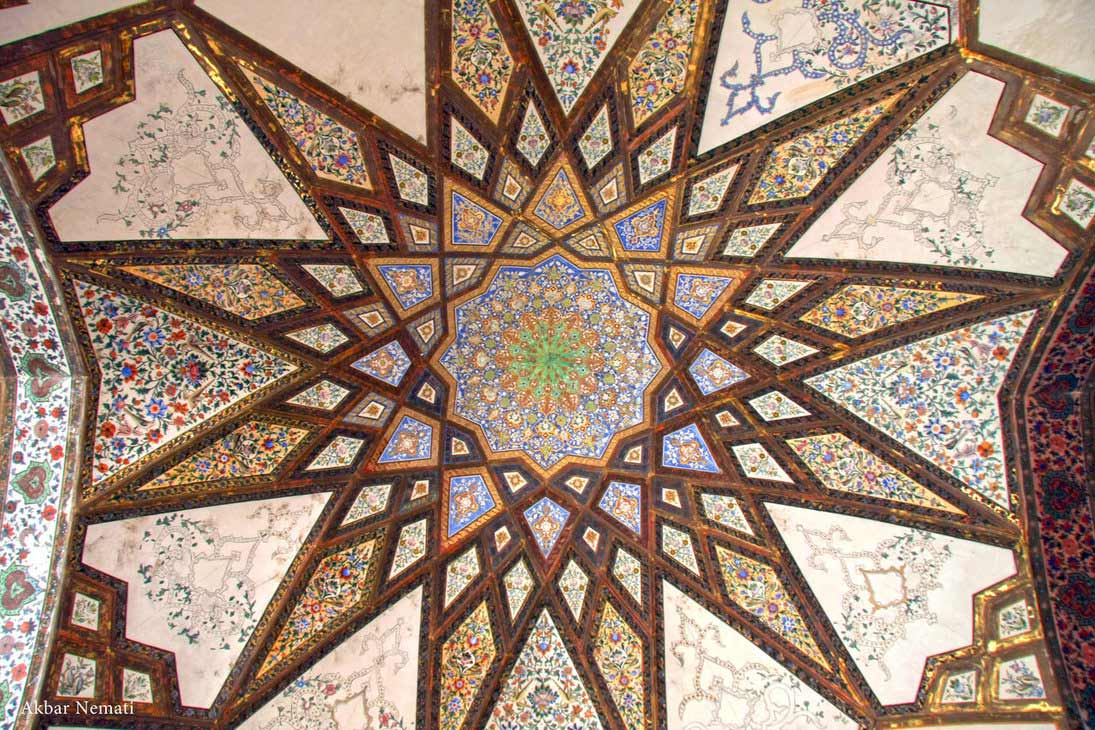
The splendid decorations of Fin Garden, Kashan
Traditional Persian Fountain
Though the garden appears lush, it is surrounded by a desert landscape where water is scarce. However, the water runs through pools and canals with abundant beauty in the garden. The water is supplied from a spring that heads toward a pool behind the Persian garden. The height difference between the pool behind the Fin garden and the canals running through it make fountains throw the water upright by gravity. The water supply system is very sophisticated. There are clay pipes one meter beneath all the pools, and they connect to the main pools on one side and are blocked on the other.
Since the ends of the clay pipes are closed, the water flows out of the fountains. Since the ground is sloping and in order to divide the pressure, the pipes’ diameters have been built differently from each other. The pipe head is thicker than its end; therefore, water throws out of them with an equal amount. Twelve springs emerge from the main pool called Howz Joosh. Then it runs through canals ornamented with turquoise tiles. The eye-catching color of the tiles is in contrast with the color of the desert surrounding the garden.
Persian Howz Architecture
There is a fascinating pool in Fin Garden called Howz Joosh. It was once covered by tiles inspired by the design of Kashan carpets. Louvre Museum displays some looted tiles from the early Pahlavi period. Once the Britains attempted to restore the pool, but they failed to do so. Professor Pirnia- an Iranian architecture professor- also wanted to restore the Howz Joosh, but as he demolished one corner, he noticed clay pipes beneath each of the holes. Based on the calculations and pipe sizes, he decided he could not restore them and stopped manipulating them. Water flow not only cools the environment in hot seasons but also provides tranquility for humans through its soft sound.
Greenery of Fin Garden
As one of the most beautiful Persian gardens, the Fin Garden of Kashan contains many trees and shrubs. Several tall trees line its pathways. Compared to the hot desert surrounding the garden, the tall trees and abundance of water are a welcome contrast. There are hundreds of cypresses plus several plane trees in Fin Garden. Regarding the old age of trees, it seems that the evergreen trees of Fin Garden are mostly cypress trees while planting a few plane trees was considered to enhance the visual quality. Aside from that, the cypress is often represented as a symbol of beauty in the Persian language. The trees are approximately 100 to 470 years old. It embraces other flowers such as lilies, eglantine, jasmine, violets, and tulips. In constructing the garden, symmetry played an important role, but slowly sidewalks and buildings in the complex disrupted the harmony.
A Tragedy within Garden’s Beauty
Besides the small bathroom constructed in the Safavid period, Qajar architects built a large bathroom (Hamam). It was in the small bathroom that Amir Kabir was murdered in 1852. Amir Kabir served as the prime minister of Nasar al-din Shah, a ruler of the Qajar Dynasty from 1848 to 1851. He made significant changes, especially in the fields of education and administration. As a result of these actions, the prime minister became popular, but he provoked the anger of the royal family. Finally, Amir Kabir was dismissed by the king of Persia. His murder occurred later in the Fin Garden after he was imprisoned there. A tragic connection to the murder led to the garden’s disrepair until 1935 when they restored it as a national monument.
Similar to Narenjestan Garden and Eram Garden in Shiraz, Dowlatabad Garden in Yazd, and Shazdeh Garden in Kerman, Fin Garden is a masterpiece combining natural and artificial elements. The architectural structures represent both Safavid and Qajar styles. In the center of the garden stands the Safavid pavilion (Kushk), and at the end stands the Qajar pavilion (Kushk) with beautiful paintings on its walls. The small bathroom and Emarat-e-Sardar (an entrance building) belong to the Safavid period. There was also the Karim Khani Nook (Kalvat-e-Karimkhani), along with the national museum and the royal bathroom during the Qajar period. Kashan National Museum is worth a quick visit as well. It showcases some ceramics and calligraphy. However, the most exquisite highlight is the shah’s delightful shotor gelou, a two-story pool house in the middle of the complex.
Are you planning to travel to Iran? Please read Things to do in Kashan and Check out our Iran tours.
Sheikh Lotfollah Mosque, Isfahan: Photos, Architecture
Sheikh Lotfollah Mosque is one of the masterpieces of Iranian architecture. It was built by the prominent architect Sheikh Bahai in the early 17th century (from 1603 to 1619) under the order of Shah Abbas the Great- the 5th Safavid king. The starting date for the construction is visible on Reza Abbasi’s inscription on the main entrance. The mosque is located on the eastern side of Naqsh-e Jahan Square (UNESCO World Heritage Site and one of the largest squares in the world 160 meters wide and 508 meters long) just opposite Ali Qapu Palace, Isfahan, Iran. Its northern side opens into the Isfahan Grand Bazaar. Visit the unique Sheikh Lotfollah Mosque When Traveling to Iran and enjoy its unique exquisite tile work.
Since the minarets have been used for the invitation of the public for saying prayers after Islam, this small private mosque- without any courtyard, minarets, and interior iwans- is believed to have been built for the women of the king’s harem. By Shah Abbas’s command, a tunnel was built from Ali Qapu Palace to the mosque, so that the females of the royal family did not have to walk across the square. They could reach the mosque without being seen in public. The guards protected the tunnel and the main entrance of the mosque and the doors were kept closed to avoid anyone to enter the building. The mosque was dedicated to Shah Abbas’s father-in-law, Sheikh Lutfallah, a revered Lebanese Islam scholar who died in 1622.
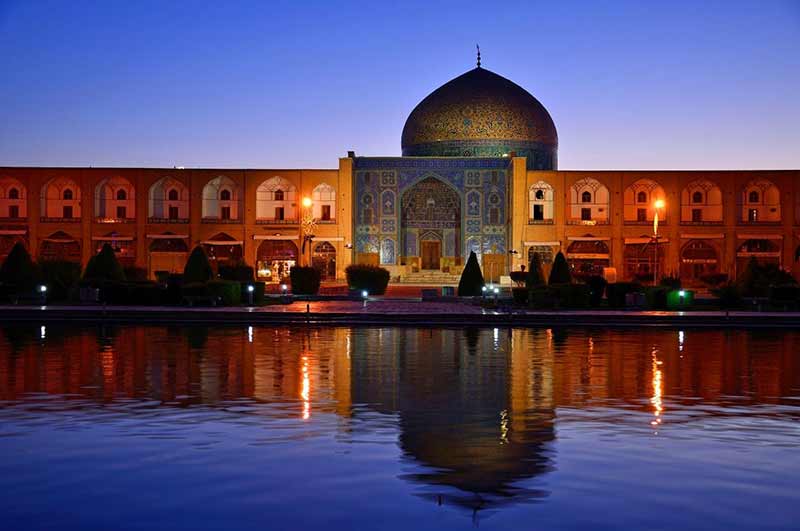
Sheikh Lotfollah Mosque on the eastern side of Naqsh-e Jahan Square
Architecture
Sheikh Lotfollah Mosque is founded on a square ground plan that turns into an octagonal form in the upper parts and finally transforms into a circle by means of the squinches. This rectangle-to-circle transition plan evokes Sassanid architecture. Despite its simple structure, this small mosque is very rich in tile work and calligraphy. Moreover, the amazing play of light and color – coming through sixteen lattice windows around the lower part of the dome- will astound the enthusiastic visitors. The façade built with marble is decorated with seven-colored mosaics (called haft-rang tiles in Persian). The calligraphy was supervised by Ali Reza Abbasi, the famous Iranian master of calligraphy.
Due to the difference between the direction of Qibla and the main entrance of the building, the architect Mohammad Reza Isfahani designed an L-shaped hallway connecting the entrance and the sanctuary of the mosque. The structure lies at a 45-degree angle against the Naghshe Jahan square eastern wall. As a result, the dome (that is 32 m high and 12 m in diameter) and the main entrance iwan do not fall on the same axis, unlike other mosques.
The tilework of the mosque is one of the best examples of Persian Islamic architecture. It is deliberately asymmetrical. This asymmetry is interpreted as a deliberate attempt to show the imperfection of human construction against the flawless creation of God. There are blue ceramic spirals inside the mosque that frame semi-vaulted corners and end in vases carved out of marble. The dome is ornamented with cream-colored glazed and unglazed tiles that colors change from cream to pink during the day. Around the dome is decorated with white, deep blue, and azure arabesques outlined in black, the Quranic inscriptions in white Thuluth writing on a dark blue background, and different names for Allah in white Kufic writing outlined in black and turquoise. It is reminiscent of Persian rugs. The way the lemon-shaped medallions inside the dome grow in size from the apex toward the drum makes the dome look taller and larger. One of the unique and remarkable features of the dome is the peacock-like shape at the center of its interior side. There is a hole in the ceiling that the sun’s rays pass through it. At certain times of the day, if you stand at the entrance of the hall, the sun’s rays seem like the tail of the peacock.
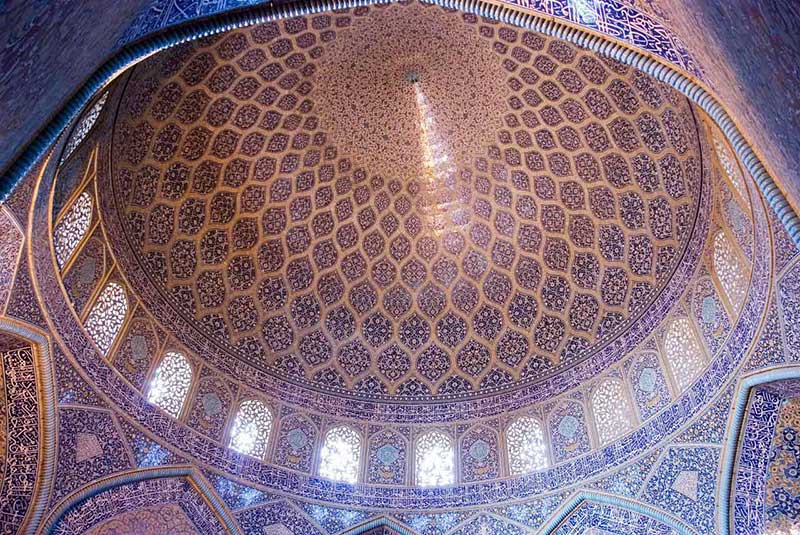
The peacock-like shape at the center of the interior side of the dome of Sheikh Lotfollah Mosque
The thick walls of the mosque are covered with blue, turquoise, white, and yellow tiles. The tiles are adorned with intricate arabesque patterns and floral motifs. The Quranic verses appear in different corners while the east and west walls are ornamented with Sheikh Bahai’s poems. The inscriptions mostly emphasize Shi’ism. It is understandable, especially regarding the date of the construction and the efforts made by the Safavid king to consolidate Twelver Shi’ism in Iran contrary to the Sunni Ottomans. There is no question that the mihrab of the mosque is one of the most spectacular examples of beauty and intricate detail. This semi-vaulted mihrab directly opposite the entrance is also decorated with moaragh mosaic, fine muqarnas, and delicate arabesque patterns. Its inner side is also elaborately ornamented with muqarnas and floral motifs. In contrast to the splendid decorations of the mosque, its basement, including 16 pillars, enjoys a simple decoration of mono-color square tiles and plaster.
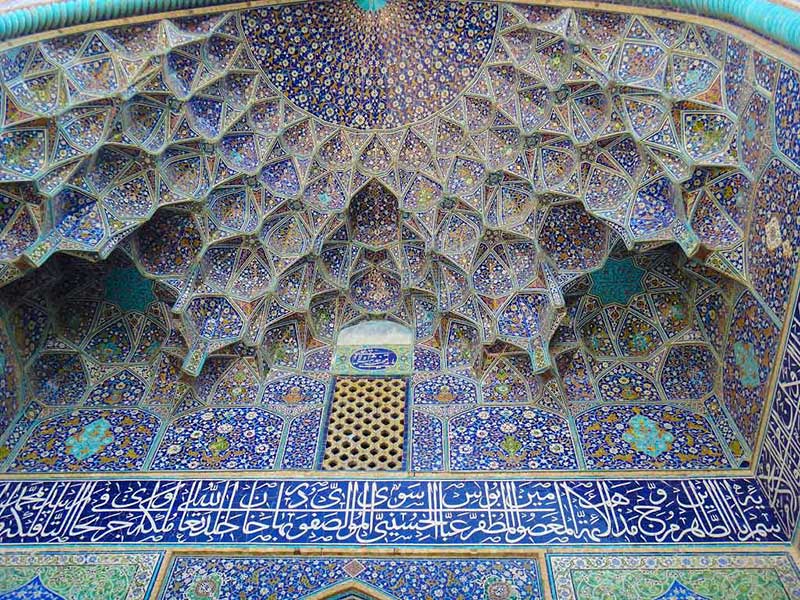
Muqarnas in Sheikh Lotfollah Mosque
Shaykh Lutfallah Mosque is one of the most magnificent attractions of Isfahan. It enjoys such unique architecture and decoration that is definitely worth visiting on the tours to Iran.
Are you planning to travel to Iran? Please read Things to do in Isfahan and Check out our Iran tours.
Saadi, the Great Persian Poet of All Time
Saadi Shirazi- Abu-Mohammad Muslih al-Din Shirazi- the great Persian poet of all time, was born in Shiraz in the 13th century. He is one of the most influential Persian poets of the medieval period, admired for his artistry in expressing the deepest moral and social thoughts in the simplest words for all ages. He is well-known as the “Master of speech” among Persian scholars and one of the best poets of classical Persian literature. His two outstanding literary masterpieces are Golestan and Bostan.
The exact date of his birth is not known. According to his qasida poems, he left home to explore the world in 1225, contemporary to the invasion of Mongols to Fars. In Golestan, composed in 1258, he addresses himself as a person who has lived 50 years, but he is still naïve and does not know much about life.
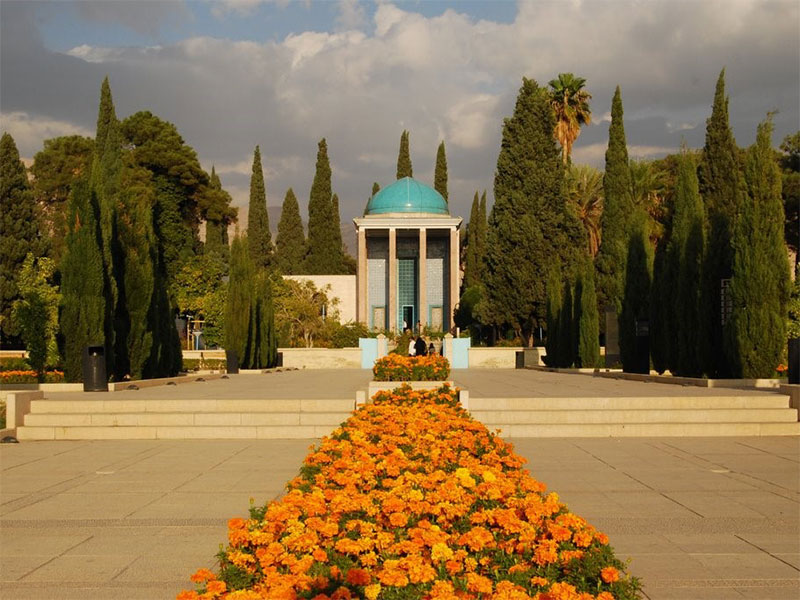
The tomb of Saadi in Shiraz
Saadi Shirazi Lifestory
After leaving Shiraz, he went to the Nezamiyeh University in Baghdad and studied Islamic sciences, theology, law, history, and Arabic literature. During his thirty-year journey, he had the opportunity to travel across Anatolia, Syria, Egypt, and Iraq. He also visited Jerusalem, Mecca, and Medina. He wrote about his travels and adventurous life in both Bustan and Golestan. Master of Speech fought alongside Sufis against Crusaders in Halab, but they captured him at Acre and held him captive there for seven years. But like many of his other stories, such as traveling to India and Central Asia, it cannot be confirmed and is considered highly suspect. Without a doubt, he lived much of his life as a wandering dervish.
Who is Saadi?
Saadi was a man of learning and traveling. He met all kinds of people, from intellectuals, merchants, preachers, farmers, ordinary people, and survivors of the Mongol invasions to Sufi dervishes and even thieves living in remote areas far from the invaded regions. Saadi was able to study society and advise and preach to people to follow wisdom and morality. He finally came back to Shiraz before 1257 CE in his late forties, and it was the time that he finished the composition of his masterpiece called Bustan. His birthplace Shiraz was where he spent the remainder of his life and was greatly respected by the residents and ruler of the city. He passed away between 1291 and 1294 in Shiraz. He has been titled a Sheikh because of his depth of knowledge.
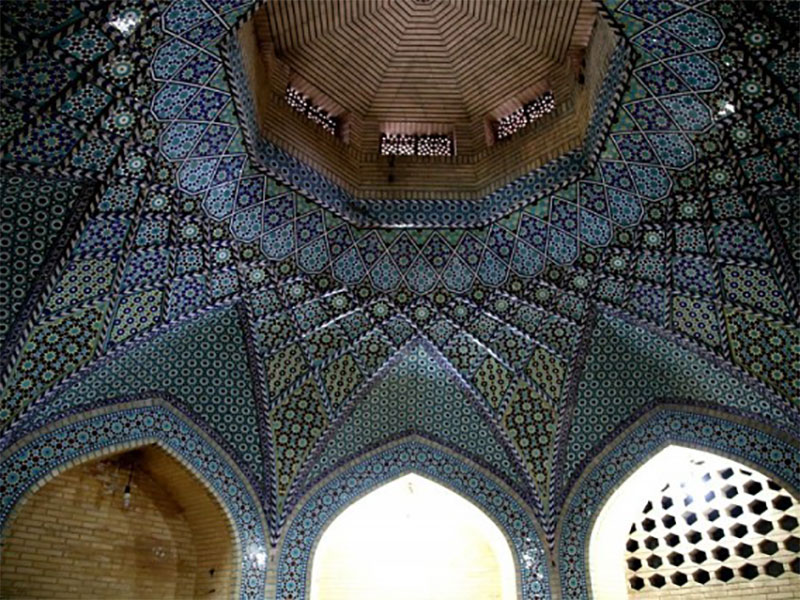
The tomb of the Persian poet Saadi displays traditional Persian architecture.
Saadi Shirazi Bustan
His best-known work Bustan (or Bostan), was completed in 1257. Bustan is entirely in verse. It includes 183 stories in ten chapters about the virtues such as justice, kindness, love, modesty, liberality, generosity, satisfaction, and happiness, and the ecstatic practices of dervishes addressing all people to have a better and happier life. Bustan was called Saadi Nameh in older versions. It contains about 4000 verses.
Golestan
His masterpiece Golestan was completed in 1258, a year after composing Bustan. It is mainly composed in prose. It includes 8 chapters, mainly about the kings’ morality, the dervishes’ behavior, the benefits of contentment, silence and talking in proper time, love and youthfulness, weakness in old age, and education. Interspersed among the stories are short poems. It is one of the most influential books in prose in Persian literature. Saadi attempts to advise people to live freely and improve their quality of life in Golestan. It contains different anecdotes, pieces of advice, and quotations. It can show the cultural and social conditions of the society at the time of Saadi very well. Some characters and stories are real, and some are fictional. It is one of the first Persian books made by a print machine in 1824 in Tabriz.
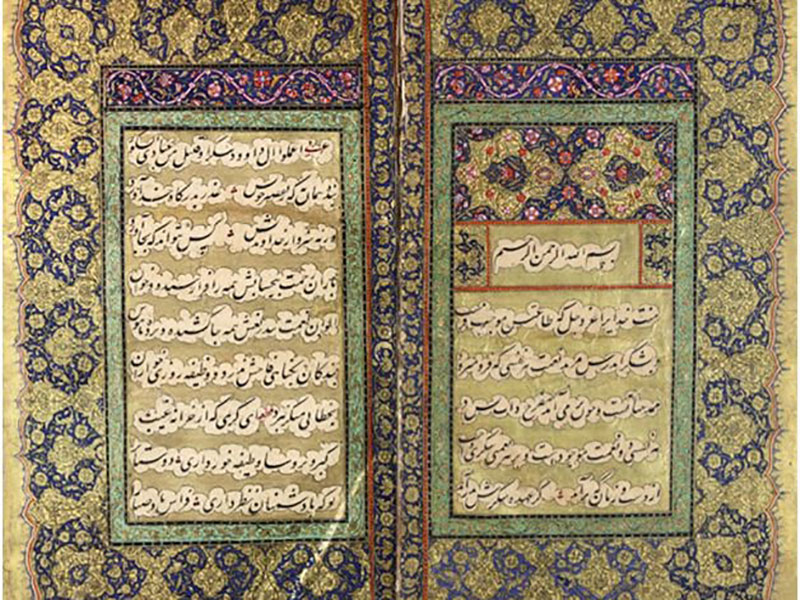
Golestan can show the cultural and social conditions of the society at the time of Saadi very well.
Persian Language and Literature
Other works of Saadi include Ghazals (love poems or Lyrics; sonnets), Qasidas (longer mono-rhyme poems or Odes), Quatrains, and short pieces in prose in both Persian and Arabic. He is known as one of the greatest ghazal-writers of Persian poetry besides Hafez. Many scholars believe the best ghazals are from Saadi and Hafiz. Saadi has about 700 ghazals, mostly with the essence of love and some with mysticism sermons. He uses irony in his works to represent and criticize the deficiencies and corruptions in the society of his time.
The Greatest Ghazal Poet
The ghazals of Saadi are collected in four groups: Old Sonnets (written in his youth); Tayebat and Badaye (written in his middle age); and Khavateem (written in his old days). Most experts believe Saadi’s Old Sonnets are about earthy love, while his Khavateem is more about mystical love, as well as ethics and piety. According to this dichotomy, they guess Saadi practically passed the earthy love to the mystical love during the different stages of his life.
Saadi’s Artistic Style of Writing
Saadi elaborately distinguishes between spiritual and mundane aspects of life in his works. He tries to visualize the deepest meanings of life in the most tangible contexts and close to conversational language as far as possible in a way that even common people can get the most out of his writings. Saadi’s writing style is called Saj’ in Persian and Arabic, and it is a kind of prose characterized by rhythm as well as rhyme. This artistic style of writing reaches its peak in Saadi’s Golestan. His prose style is described as simple but impossible to imitate.

Visuals of the tomb of Saadi Shirazi at night
Saadi Shirazi Poems
The writing style of Saadi undoubtedly had a huge influence on Persian literature and many great poets who followed him. There is a surprising similarity between his language and modern Persian. After about eight centuries, his works are still easy to understand and admirable in different languages. Many of the Persian proverbs have been taken from his works. Translations include “the proof of the pudding is in the eating”, “what can you expect from a hog but a grunt?” and “Haste makes waste.” Among the well-known western poets who translated Saadi’s works are Goethe and Andre du Ryer- the first European who presented Saadi to the west for the first time in 1634. Golestan was translated into Latin in 1651. Sir Richard Francis Burton translated Golestan into English for the first time.
In one of the most well-known immortal poetries of Saadi, he considers all humans as different parts of a whole body, regardless of social barriers and race:
Human beings are members of a whole,
In the creation of one essence and soul.
If one member is afflicted with pain,
Other members uneasy will remain.
If you have no sympathy for human pain,
The name of a human you cannot retain.
This poem conveys such a deep humane universal concept that is printed on the ten-thousand-Rial bill to remind everyone of the love and peace in everyday life.

Saadi’s poem printed on the ten-thousand-Rial bill
Tomb of Saadi
It is one of the major tourist attractions in Shiraz to visit his mausoleum, also known as Saadieh. It is located in a beautiful garden beside Delgosha Garden (dating back to the Sassanid era). The tomb was built in the 13th century. Unfortunately, it was destroyed in the 17th century. The present-day building was built between the years 1950 and 1952. It was inspired by Chehel Sotoun and built by the architect Mohsen Foroughi. Many Persian elements have been used in its architecture. It is also a National Heritage Site. It is visited annually by thousands of visitors who respect him and adore the eloquence in his works. Most of the tours to Iran include Saadieh in their itineraries while visiting Shiraz during their travel to Iran. To commemorate Saadi, 21 March is celebrated as the National Day of Saadi in Iran every year.
Are you planning to travel to Iran? Please read Things to do in Shiraz and Check out our Iran tours.
Nasir al-Mulk Mosque (Pink Mosque), Shiraz: Photos, video
Nasir al-Mulk Mosque also known as the Pink Mosque is an elegant piece of art and architecture that belongs to the end of the 19th century. Located in Shiraz, it is a colorful mosque built during the Qajar dynasty. Nasir al-Mulk Mosque takes its name from one of the Qajar rulers – Mirza Hasan Ali Nasir al-Mulk – who ordered the construction of the mosque. Mohammad Hasan-e-Memar and Mohammad Reza Kashi-Saz were the professional designers of such an exquisite mosque. The construction of the mosque lasted from 1876 to 1888. Nasir al-Mulk Mosque in Shiraz-the combination of art and architecture – is one of the attractions for many tourists who travel to Iran.
Since the pink color and stained glass windows are applied elaborately in the structure and design of the Mosque, it is known by different names. Pink Mosque, Rainbow Mosque, Mosque of colors, and Kaleidoscope Mosque all describe different interpretations of visitors from this fantastic site.
At dawn, the sun shines through the stained glass windows of the Mosque and it glides from the right-hand side to the left-hand side to fill the inside with the glory of various colors combined. The vivid colors spread over the ground, the Persian rugs, the ceiling, the walls, the tiles, and the arches give soul to the solid structure of the mosque. They caress the amazed visitors’ and worshipers’ faces and inspire photographers with great ideas to take amazing pictures. Maybe the designers had aimed to construct such an astonishing space to hold everybody in awe and to create a sacred space for prayer.
Nasir al-Mulk Mosque has two eastern and western shabestans. The eastern Shabestan has a gorgeous tiled altar and twelve columns along with stained glass windows. The arts of tiling and painting in Shabestans, and the beautiful decorations of Mihrab have extraordinary beauty. The harmony among columns, fantastic geometric patterns, the play of light and colors, and the splendid Muqarnas all dazzle the eyes of visitors and photographers. The mosque has great elements of traditional architecture such as a central fountain, an iwan, Panj kāseh-i (five concaves), faience, and plaster works.
Nasir al-Mulk Mosque has been inscribed as one of the national heritage sites of Iran and it annually attracts many travelers to Iran. The best time to visit the mosque is early in the morning and about 8 to 9 am. This is the best time to see the light passing through the stained glass windows and making a kaleidoscopic space that amuses travelers, photographers, and worshipers. The interesting point is that Nasir al-Mulk Mosque is still used for worship. Today this glorious mosque is under protection by Nasir al-Mulk’s Endowment Foundation.
Are you planning to travel to Iran? Please read Things to do in Shiraz and Check out our Iran tours.

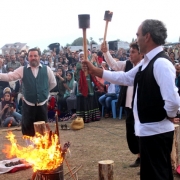
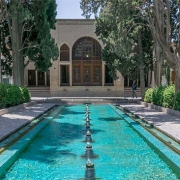
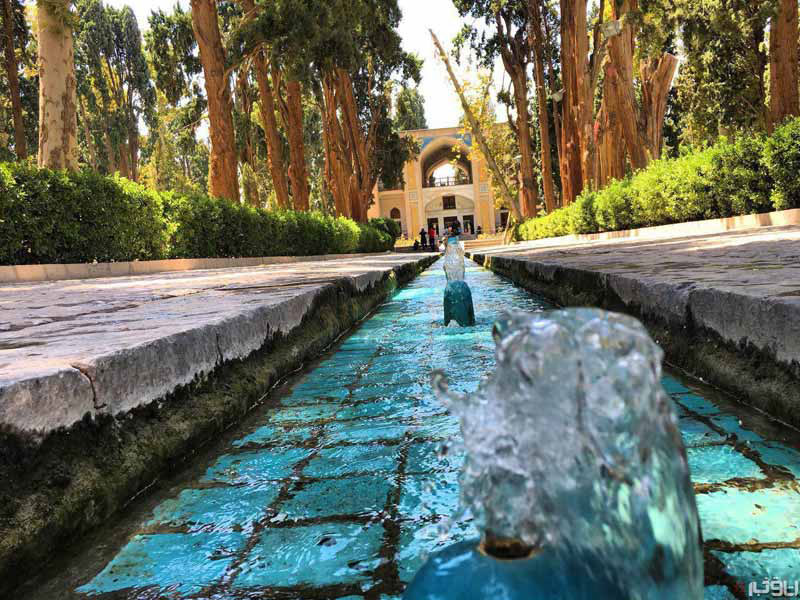
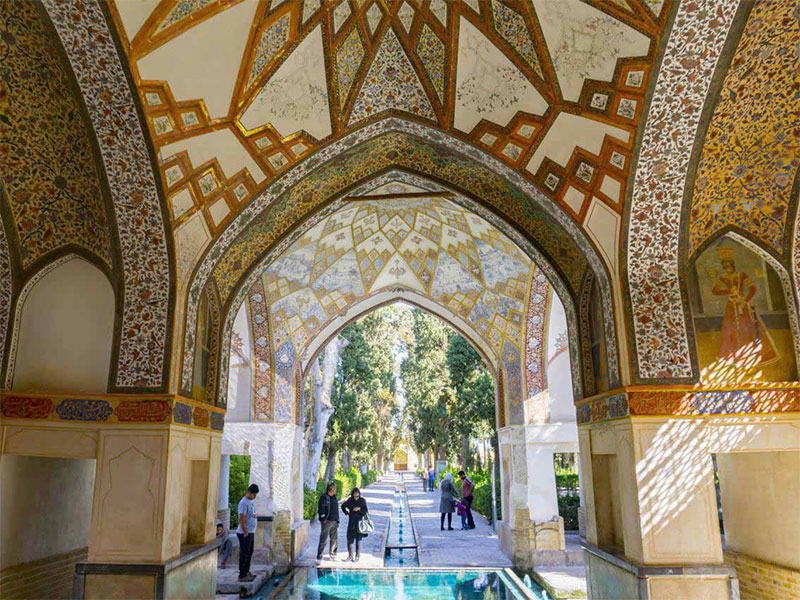
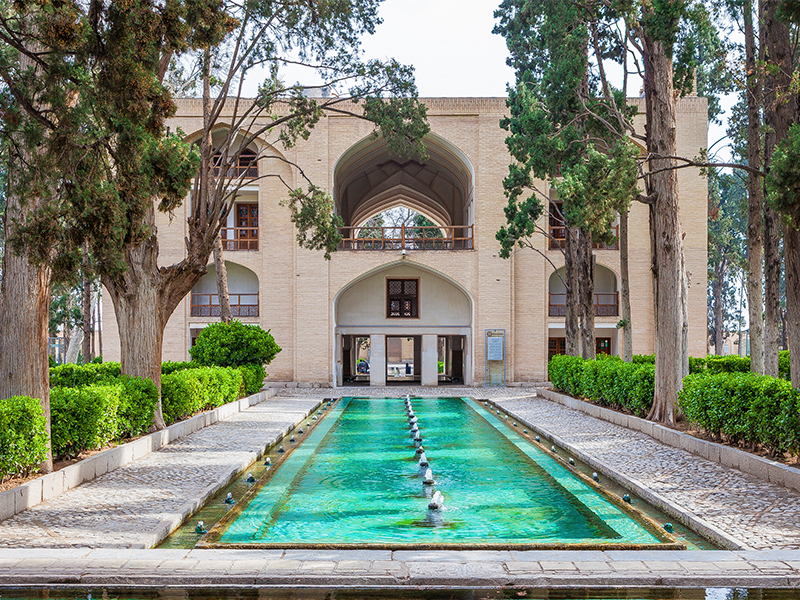
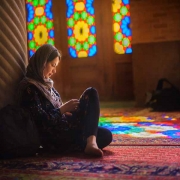
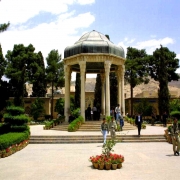
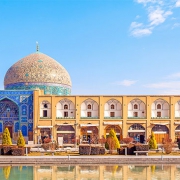
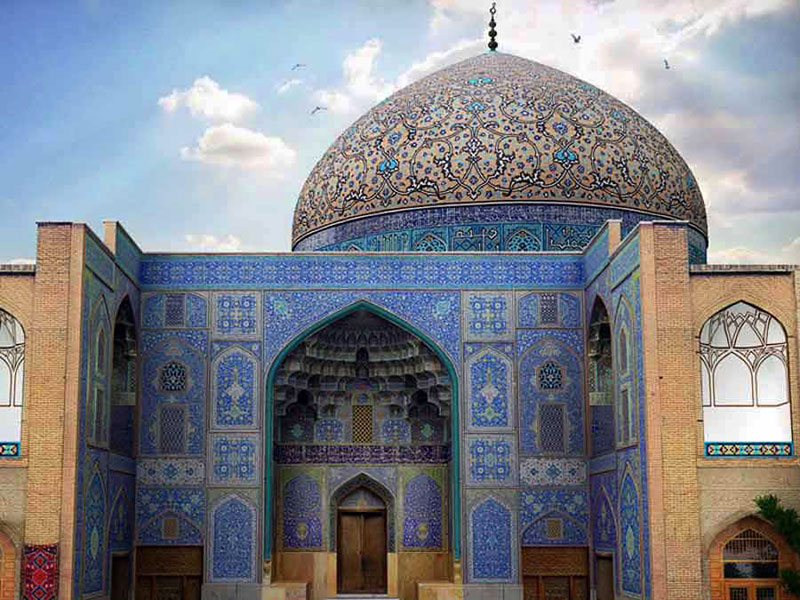

 Iran Doostan Tours
Iran Doostan Tours